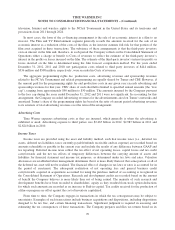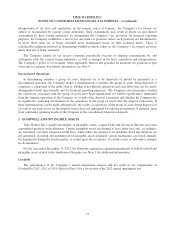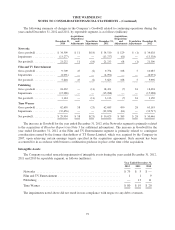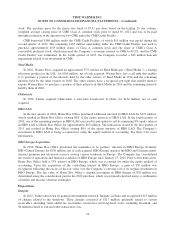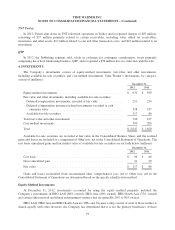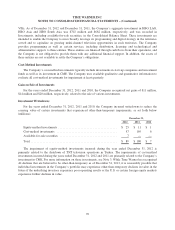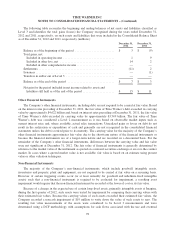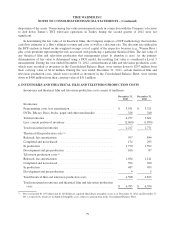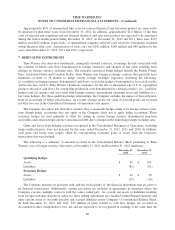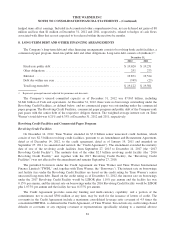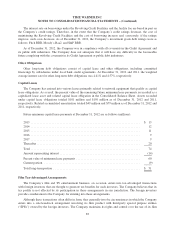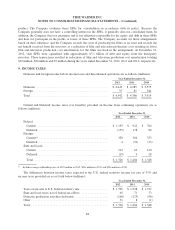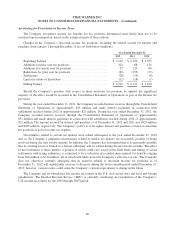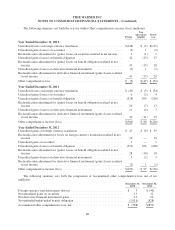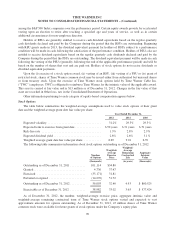Time Magazine 2012 Annual Report Download - page 96
Download and view the complete annual report
Please find page 96 of the 2012 Time Magazine annual report below. You can navigate through the pages in the report by either clicking on the pages listed below, or by using the keyword search tool below to find specific information within the annual report.
TIME WARNER INC.
NOTES TO CONSOLIDATED FINANCIAL STATEMENTS – (Continued)
Approximately 89% of unamortized film costs for released theatrical and television product are expected to
be amortized within three years from December 31, 2012. In addition, approximately $1.6 billion of the film
costs of released and completed and not released theatrical and television product are expected to be amortized
during the twelve-month period ending December 31, 2013. At December 31, 2012 and 2011, there were $173
million and $182 million, respectively, of unamortized computer software costs related to videogames included
within theatrical film costs. Amortization of such costs was $182 million, $163 million and $40 million for the
years ended December 31, 2012, 2011 and 2010, respectively.
7. DERIVATIVE INSTRUMENTS
Time Warner uses derivative instruments, principally forward contracts, to manage the risk associated with
the volatility of future cash flows denominated in foreign currencies and changes in fair value resulting from
changes in foreign currency exchange rates. The principal currencies being hedged include the British Pound,
Euro, Australian Dollar and Canadian Dollar. Time Warner uses foreign exchange contracts that generally have
maturities of three to 18 months to hedge various foreign exchange exposures, including the following:
(i) variability in foreign-currency-denominated cash flows, such as the hedges of unremitted or forecasted royalty
and license fees owed to Time Warner’s domestic companies for the sale or anticipated sale of U.S. copyrighted
products abroad or cash flows for certain film production costs denominated in a foreign currency (i.e., cash flow
hedges) and (ii) currency risk associated with foreign-currency-denominated operating assets and liabilities (i.e.,
fair value hedges). For these qualifying hedge relationships, the Company excludes the impact of forward points
from its assessment of hedge effectiveness. As a result, changes in the fair value of forward points are recorded
in Other loss, net in the Consolidated Statement of Operations each quarter.
The Company also enters into derivative contracts that economically hedge certain of its foreign currency risks,
even though hedge accounting does not apply or the Company elects not to apply hedge accounting. These
economic hedges are used primarily to offset the change in certain foreign currency denominated long-term
receivables and certain foreign-currency-denominated debt due to changes in the underlying foreign exchange rates.
Gains and losses from hedging activities recognized in the Consolidated Statement of Operations, including
hedge ineffectiveness, were not material for the years ended December 31, 2012, 2011 and 2010. In addition,
such gains and losses were largely offset by corresponding economic gains or losses from the respective
transactions that were hedged.
The following is a summary of amounts recorded in the Consolidated Balance Sheet pertaining to Time
Warner’s use of foreign currency derivatives at December 31, 2012 and December 31, 2011 (millions):
December 31,
2012
December 31,
2011
Qualifying Hedges
Assets ...................................................... $ 69 $ 105
Liabilities ................................................... (81) (91)
Economic Hedges
Assets ...................................................... $ 10 $ 30
Liabilities ................................................... (20) (16)
The Company monitors its positions with, and the credit quality of, the financial institutions that are party to
its financial transactions. Additionally, netting provisions are included in agreements in situations where the
Company executes multiple contracts with the same counterparty. As a result, net assets or liabilities resulting
from foreign exchange derivatives subject to these netting agreements are classified within Prepaid expenses and
other current assets or Accounts payable and accrued liabilities in the Company’s Consolidated Balance Sheet.
At both December 31, 2012 and 2011, $19 million of gains related to cash flow hedges are recorded in
Accumulated other comprehensive loss, net and are expected to be recognized in earnings at the same time the
80


